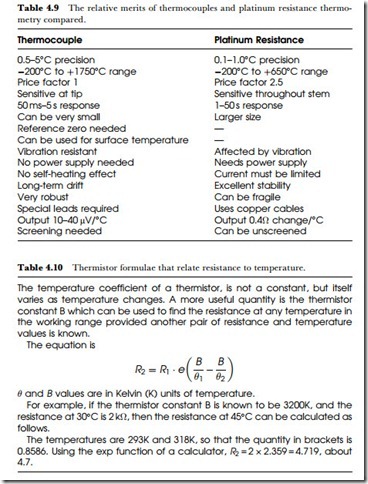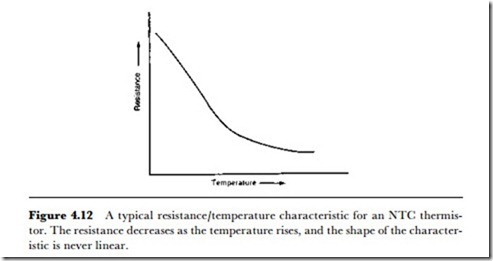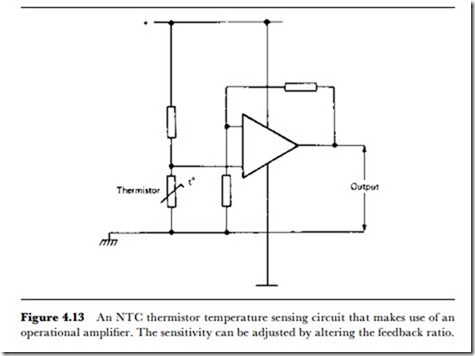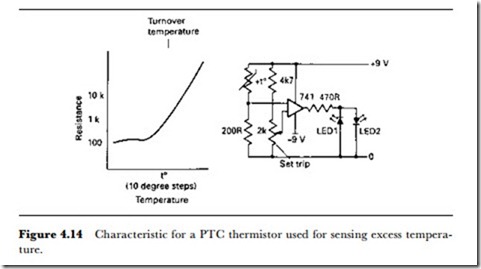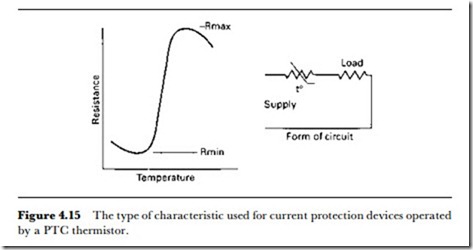Thermistors
Thermistors are a form of temperature-sensitive resistors formed using mixtures of oxides of exotic metals. The constructional methods are similar to those used for carbon composition resistors. Some of these mixtures have positive temperature coefficients, and in most cases it would be meaningless to quote a value for temperature coefficient, positive or negative, because the value is not a constant. The thermistors with a positive temperature coefficient are very non-linear, but the more common negative temperature coefficient types follow a roughly logarithmic law with no violent changes in resistance.
Given that the resistance of a thermistor is known at one temperature ()2, it can be calculated for another temperature ()1 by using the formula illu-
strated in Table 4.10. The use of () rather than T for temperature in this formula is a reminder that the temperatures must be in units of Kelvins (absolute temperatures). The Kelvin or absolute temperature is obtained by adding 273 to the Celsius temperature. If you need to work to two places of decimals of temperature, use the figure 273.16.
Thermistors can be obtained in a variety of physical forms, as beads, miniature beads, plates, rods, and also encapsulated in metal containers. Negative temperature coefficient (NTC) thermistors are used for temperature control applications such as low-temperature oven controllers, deep- freezer thermostats, room temperature sensors and process controllers. Temperature limits range from 150oC to 200oC, with a few types able to withstand 600oC. The range of temperature that a thermistor can handle depends on the associated circuit, because the range of resistance will be very large compared to the range of temperature.
The typical NTC thermistor characteristic is shown in Figure 4.12, and it displays a negative change of resistance with increasing temperature. The shape of the characteristic is exponential rather than linear, and the useful temperature range is comparatively small.
In any of these applications, NTC thermistors have considerable advantages as compared to the old bimetal thermostat, notably the absence of any hysteresis effects (switching on at a different temperature than that for switching off). NTC thermistors can also be obtained in evacuated envelopes for use in such purposes as oscillator limiters and controllers for voltage-controlled amplifiers.
Thermistor circuits in general require the use of pre-set potentiometers in order to make working adjustments, but circuit costs can be reduced by employing curve matched thermistors whose resistance values are guaranteed to within close limits at each of a large range of temperatures. Thermistors of all types will also have quoted values of dissipation constant and time constant. The dissipation constant is the amount of power (in milliwatts) that is required to raise the temperature of the thermistor by 1oC
above the ambient temperature. For the evacuated bulb type, the dissipation constant is very small, of the order of 12 JWjoC, so that the resistance
of this type of thermistor is substantially altered by only very small amounts of signal current. For temperature-sensing thermistors, values of dissipation constant in the range 70 = 500 JWjoC are typical.
The time constant for a thermistor is defined as the time needed for the resistance to alter by 63% of the difference between an initial value and a final value caused by a change of temperature. Time constant is measured with negligible current flowing, because otherwise the figure would be altered since part of the heating is internal rather than external. The figure of 63% may seem odd, but it corresponds to the definition of time constant for other networks, such as a capacitor and a resistor. By making the defini- tion in this way, the value of time constant is genuinely constant over a large range of temperature changes. Time constants of 5-11 s are typical of the physically small thermistors (miniature beads and the evacuated bulb types), with much larger values for others, 18-25 s for the larger beads, and as high as 180 s for thermistors that have been assembled into tempera- ture sensing probes.
NTC thermistors can be constructed from semiconducting materials with values of temperature coefficients that are usually much larger than the (positive) temperature coefficients of resistors. The phrase NTC resistor is used for devices with fairly small negative values of temperature coefficient, and the term thermistor is reserved for the types that have large negative values of temperature coefficient. Most of the thermistors that are incorpo- rated into temperature-sensing circuits are of the NTC type.
PTC THERMISTORS
Positive temperature coefficient (PTC) thermistors are a more recent development, used mainly for protection circuits for sensing temperature or current. Unlike the NTC types, these PTC thermistors have a current- voltage characteristic that exhibits a change in direction, and two basic types are used, both depending on compounds of barium, lead and strontium titanates (ceramic materials). The over-temperature protection type of PTC device has a switchover point at a reference temperature (or trip temperature, T r). At temperatures lower than the trip temperature the resistance of the PTC device is fairly constant, but around the trip temperature the PTC characteristic takes over and their resistance rises very sharply as the temperature rises. A typical graph of resistance plotted against temperature, along with a trip-sensing circuit, is shown in Figure The sudden change in resistance can be used to operate an indicator or to switch other circuits for purposes such as motor protection or for pre- venting overheating of transformers.
The other type of PTC thermistor device is used for over-current protection circuits, and its resistancejtemperature graph is illustrated in Figure This characteristic follows an S-shaped curve which has two turn- over points, one at a point of minimum resistance Rmin and the other at the maximum resistance point Rmax. Between 0oC and Rmin, the temperature coefficient is negative, and the coefficient is also negative at the temperatures in the region higher than Rmax. Between Rmin and Rmax the temperature coefficient is large and positive. In this PTC region, the change of resistance can be as large as 100% for each oC rise in temperature.
With one of these devices wired in series with a load, the load is protected against excessive current. At the working current, the PTC device is in its
low-resistance state, allowing most of the applied voltage to be across the load. When the current is increased, the thermistor will suddenly switch to its PTC mode, assisted by self-heating as more of the applied voltage will now be across the thermistor, until the current flowing in the whole circuit becomes very small. The circuit can be arranged so that it is self-resetting, returning to normal when the thermistor cools, or requires the circuit to be reset by switching off the current and allowing the thermistor to cool.
The change of resistance per unit change of temperature for a PTC ther- mistor can be so abrupt that circuit devices such as bridges and Schmitt triggers are sometimes not necessary. In a very few applications, the PTC thermistor can be used directly, but it is usually undesirable to have the con- trolled current passing through the thermistor, and more usually the thermistor is part of a transistor switch or an operational amplifier circuit. The output of such a circuit is not particularly linear, but the sensitivity can be high and the response can be rapid. One particular advantage is that the sensing element can be very small.
• Note that if an op amp with sufficient gain is used to amplify the voltage across a thermistor, any type of thermistor can be used to sense excessive temperature. The advantage of using a PTC thermistor is that many types of sensing applications can use circuits that require no op amp.
The connection of a thermistor to a switching circuit has the advantage, as compared to bimetallic strip devices, that it can be arranged so as to have zero hysteresis if this is a useful feature. For most switching purposes, however, some hysteresis is desirable in order to prevent rapid switching on and off as air currents strike the detector. The more elaborate temperature sensing systems that make use of thermistors are microprocessor controlled, and a form of time hysteresis is used. The temperature sensing output from the thermistor is monitored at short intervals, and a change registered only if the direction of temperature change is consistent. This allows much more rapid response to a temperature change than the conventional form of hysteresis, although the sensing intervals have to be adjusted to suit the type of use.
Transistors themselves can be used as sensing elements, because many transistor parameters follow an exponential negative temperature characteristic. The inherent amplification of a transistor makes the use of the temperature sensitivity of base-emitter voltage attractive as a sensing system, because the output can be taken in amplified form from the collector. The use of transistors as temperature sensors, however, is confined mainly to temperature compensation of transistor and IC circuits.
